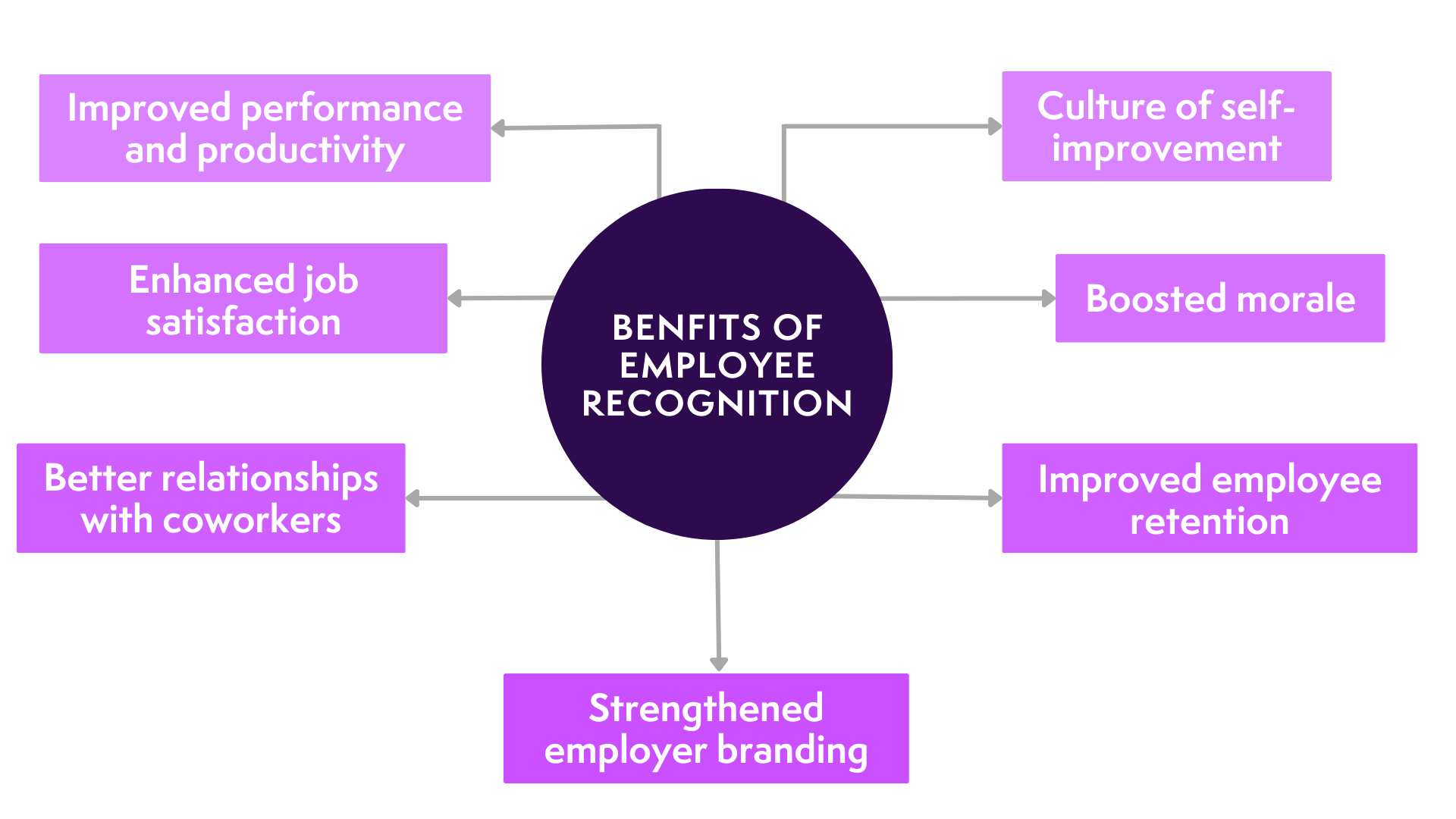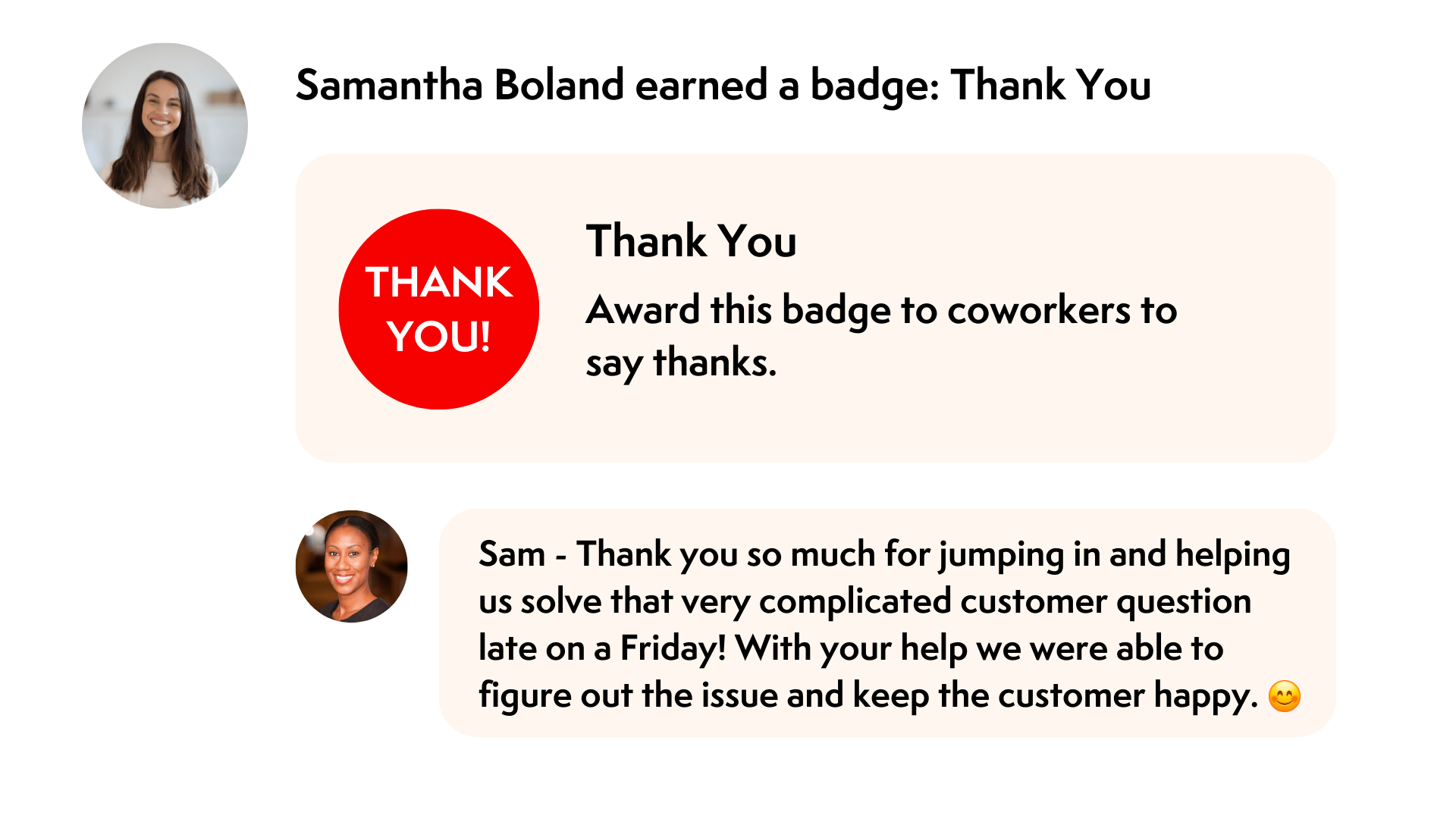Employees work hard and want to feel valued by their managers and the company at large. In return for this service, team leaders and management need to put in special effort to recognize employees. An effective employee recognition program can deliver significant benefits to employees and management alike.
When workforces become disconnected and company values can feel forgotten, a few precise and key actions can bring everyone together again. Employee recognition is a great way to do so, but it must always be honest, heartfelt, and genuine.
Recent research found that employees are 3.8% more likely to agree that they are strongly connected to the culture at work when recognition is an important part of that culture. Establishing employee recognition programs will provide much-needed structure, but it should never be as simple as just recognizing employees who have done a good job.
Let’s take a deep dive into what makes effective employee recognition, and how you can set up a successful employee recognition program that celebrates the people at the heart of your organization.
What is employee recognition?

Employee recognition is exactly what it sounds like: an occasion when the efforts, behaviors, or outcomes achieved by an employee are considered noteworthy.
It might be work that really reflects the core company values and goals, or it could just be for a job well done. Maybe someone has been extra thoughtful and considerate that month, and so the company wants to reward them for it.
This is especially important in a modern workplace where employees might hold a lot of autonomy in their working practices. Not every task may be declared and the hardest and most complex of projects might not always be the most obvious to those on the outside. Employee recognition helps shine a light on them and ensures that everyone is supported and celebrated in their efforts. Research found that employees who receive great recognition are 20x more likely to be engaged than their colleagues who receive poor recognition.
Employee Recognition vs Employee Rewards
When discussing an employee recognition program and rewarding employees, it is easy to understand how they might intersect and overlap. However, both have roles to play in a balanced and strategic recognition program.
Recognition primarily focuses on appreciation and acknowledgment, while rewards are a bit more tangible. Though both can be considered to be incentivizing, some employees might respond better to monetary recognition and reward over just words of praise. Both can provide direct motivation and can help to foster a company culture when used correctly.
Common types of employee recognition
An employee recognition program can take many forms. It can be both structured and unstructured, something recorded or delivered on the fly. Ultimately, it comes down to what the company and its employees want to see.
Formal recognition
Formal recognition is written and often recorded somewhere official, such as an employee’s file or official record. It might involve the presentation of a certificate or some other notification that formally recognizes the employee. Companies may choose to make the presentation of this recognition a public and recurring event for the whole team to participate in.
Informal recognition
Informal recognition is often delivered on the fly. A manager notes that an employee is worthy of praise and will deliver it either in person during a meeting, internal chat, or even just in passing across the office or on a call. It should be quick and easy, nothing more than a pick-me-up.
Peer-to-peer recognition
Managers should not be the only ones who can deliver recognition. Peer-to-peer recognition is crucial for supporting employee morale and fostering strong teams. If a team member sees something they like from a colleague, they should be able to shout them out.
Tangible recognition
Who doesn’t want to be rewarded for a hard day’s work? Though words of praise go a long way, adding tangible rewards will always be appreciated. If you decide to keep employee recognition quite simple with a good ol’ Employee of the Month program, consider offering tangible rewards alongside the title itself.
Employee recognition examples
So, what does good employee recognition look like? Understandably, it can take many forms. Some leaders will prefer to deliver recognition in certain ways. Some employees will want to feel valued in certain ways and will respond better to being recognized and praised in those ways compared to others. Here are some of the ways employee appreciation and recognition can be expressed.
Recognizing excellent performance
First and foremost, managers should always recognize excellent performances from their employees. When someone has done something worthy of being praised, that needs to be celebrated. If an employee has gone above and beyond when meeting a project’s deadlines, the company should take extra care to recognize that.
When management recognizes excellent performance, the employee will be motivated to continue doing a good job and delivering on, or even prior to, their deadlines. Likewise, their colleagues might also be motivated to improve their own performance so they too can receive praise. Even praising one specific member of a team can cause the performance of everyone to improve.
Recognizing good attitudes
Having a team with a good attitude can make all the difference. While we can’t expect employees to approach every task with a smile and an enthusiastic attitude, working with someone with a negative outlook can quickly drain us too.
Working alongside an energy vampire can make it seem like all the enjoyment has been sucked right out of a task even if you approached it positively. Though employee motivation should mainly fall to leaders, team members may also need to support one another on projects, and also just to build strong relationships amongst colleagues.
This is why trying to maintain that positive outlook is so important. Leadership needs to recognize good attitudes and reward them for uplifting morale and encouraging other team members to approach tasks with a similar attitude. Even the most horrible and complex of tasks can feel a bit better when you have someone by your side who keeps the mood up.
Recognizing goal accomplishment
Every employee should have a set of goals that they want to work towards. These can be learning and development goals that will help them to further their own careers, or they could just be personal goals that they want to achieve such as the development of new skills and the gaining of new experiences.
Though not every goal accomplishment may be linked to the success of the company, public recognition of these goals can really help to celebrate the accomplishment for everyone. Celebrating these wins, big or small, and ensuring that employee recognition efforts carry beyond the scope of work tasks is important.
Service awards
In today’s workplace culture, it is actually quite rare for employees to stay for years at a time. Even if they hear nothing but positive feedback and genuinely helpful constructive criticism, many employees are motivated to move on to new challenges and experiences after an average of 4.1 years according to data from the Bureau of Labor Statistics.
When we do have employees who decide to stay with a company for a long time – putting in the effort and working hard – we need to ensure that there is a formal recognition program in place that recognizes this long service. Some employees start with very low intern positions and rise all the way to the top. They deserve to be recognized along the way.
Performance-based rewards
Acknowledging and appreciating good performance should form a key part of any culture of recognition. Employees thrive when they are given challenges to complete, and they do so even more when they are allowed to set these challenges themselves. Performance-based rewards might not technically be tied to goals for the overall team, but they can feed into success metrics for the business overall.
As an example, a recognition program might reward employees in the Sales team if they can close a certain number of deals per month. A customer service rep who consistently receives high praise from the clients and customers they serve might also be a candidate for this type of reward.
Benefits of employee recognition
What do we see when we take the time to ensure that there is strong employee recognition in place? The benefits of employee recognition can be far-ranging and can strengthen many different parts of the business. They can include:
1. Improved performance and productivity
Employees are motivated to deliver their assigned workload and to do so in a productive manner. Everything from employee accomplishments to engagement and deadlines could possibly be acknowledged and rewarded. Recognizing employees who do deliver on their deadlines and who work to become more efficient and productive can lead to them not only continuing to exceed expectations but also inspiring colleagues to do the same.
2. Enhanced job satisfaction
Everyone loves to hear when they have delivered a job well done! Heartfelt and frequent recognition can help employees feel valued and can help show them how they help the company achieve its goals. Though employees’ contributions aren’t always the most visible to them when they are focused on their tasks, receiving recognition for their efforts can help them find satisfaction in what they are achieving.
3. Better relationships with coworkers
If you want to empower employees and help them achieve their full potential, it is easier to do so when the whole team is involved. Encourage employees to share experiences and meaningful recognition, and they should begin to build stronger bonds with one another. A positive company culture is created when employees recognize and support those around them and help one another feel valued in what they are doing.
4. Improved employee retention
When employees’ contributions are noticed and acknowledged, employees are more motivated to stay in their roles and not look elsewhere. They know that they are appreciated, and they truly feel valued in their positions. If you feel like employee turnover is particularly high, focus on employee happiness and appreciation. A big positive impact can be made simply by recognizing the hard work being put in, and this can help employees decide to stay.
5. Creation of a culture of self-improvement
When people have to wait around for permission, they become frustrated and begin to look elsewhere. By giving employees autonomy and allowing them to set their own schedule for self-improvement and learning, they have the freedom to pursue their passions. Then, once they have met their goals, make sure to recognize their achievements.
6. Boosted morale
An effective recognition program can help boost morale across every level of the company by making employees feel appreciated. When workers feel adequately recognized and encouraged to spread their appreciation to peers, leadership is in a better position to motivate employees.
7. Strengthened employer branding
An employee recognition platform can form a key part of strengthened employer branding. Every business should create an employee value proposition statement, a formal promise they offer potential hires that tells them about company values and culture. This is the place to shout about the employee experience and culture of recognition at play here!
How to create a successful employee recognition program
Asking people to just give shoutouts when they feel like it will never work won’t take you far. The best employee recognition programs have structure and goals. This encourages employees to actually engage with the system, and make it a success. Here are our top tips for creating a successful employee recognition program.
1. Establish clear criteria and goals
As always when launching something new at work, you need to make sure that you establish clear criteria and goals so that you can measure the success of the program overall. People might seem keen at first, but without goals and metrics you can actually measure, you won’t be able to actually see if a difference is being made.
As an example, you might decide to add a new question to the monthly employee feedback survey asking if the employees have either given or received recognition.
2. Get the bosses onboard and aligned
No matter what, you have to get senior leaders on board. This is an excellent opportunity to see leading by example in action. When people regularly see those public recognition moments where they and their peers are shown to be valued, they will be more likely to give a little themselves.
On top of this, having the bosses onboard is key for communicating the program effectively to their teams. If we want to see employee engagement, they have to be free to ask questions and truly understand the program. If management is umming and erring over the new launch, employees could feel confused as to what is actually expected of them. Then no one will get the praise they deserve.
3. Get the timing right
It is very important to judge timing correctly. Though employee appreciation and recognition should be something that takes place frequently, formal employee recognition programs might require some additional timing and setup.
The best time to think about them can often be at the end of the month, or the end of a quarter if you would like a little more time to consider. At this point, many teams take the opportunity to look back over the work that has been completed, and they can then offer their thoughts and opinions on what has transpired. In addition to discussing outcomes and potential changes to processes, this is a time to reflect on who is worthy of praise, and where the employee recognition should go.
4. Leverage your technology and company intranet
Your company intranet will play a key role in how employee recognition is handled. It is one of the easiest ways to hand out appreciation quickly, and it is also a great place to spot the impact of employee recognition pretty quickly.
An intranet can do many things for the workplace. It can be used for formal announcements for the whole company to see, or it might be a small message handed over via a chat in a team hub. Small acts of social recognition like this make it easier than ever to just give someone a casual shoutout. You can even offer badges to incentivize people to give those all-important shout-outs to their coworkers. This extra bit of personalized recognition really can make all the difference!
5. Use alerts and analytics to highlight accomplishments
You can throw around as many recognition ideas as you like and help employees feel really good about giving and receiving appreciation from their colleagues, but you need to be able to track your efforts too. This is why making use of an intranet like Axero can be key.
Successful businesses have a good grasp of their accomplishments, and this includes employee engagement and other social factors alongside big sales targets and conversion rates. By building in metrics (hint: employee engagement tools can be helpful!) to give you a sense of your employee recognition program’s performance, you will be in a much better position to see the effects and value it brings.
Build your employee recognition program with Axero
Employee appreciation does not need to be anything complicated. A handwritten note is great, but most of the time employees just want to hear that they are doing a good job. However, employee recognition might just be the first part of the puzzle.
Do you think employee performance could be a little better in your team? Do you want to build the ideal company culture where publicly acknowledging help given and received is second nature? This can go much deeper than setting up employee recognition programs and making sure everyone feels properly appreciated.
Your entire digital workspace might be due for an overhaul. Increase employee engagement and ensure that employees feel valued by giving them an online workspace that meets their needs. A good intranet should centralize all communication and knowledge-sharing within your company.
Axero provides the one-stop shop for everything you need: employee recognition, document and knowledge sharing, workplace culture, and collaboration in one platform accessible by your employees no matter where they might be.
Book a demo with us to find out how we can help you create the perfect platform for employee recognition, team collaboration, or sharing wins!


















 info@axerosolutions.com
info@axerosolutions.com 1-855-AXERO-55
1-855-AXERO-55


